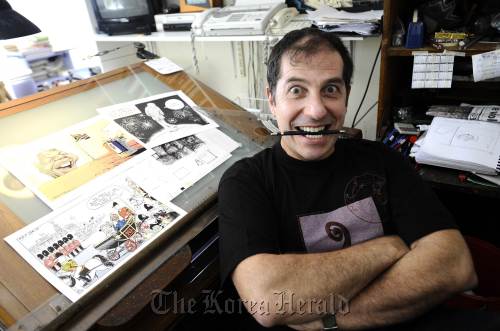CAPE TOWN (AFP) ― South Africa’s apartheid state locked him up, Nelson Mandela was a fan and Jacob Zuma is suing for millions: all have been rich pickings for the fearless satire of cartoonist Jonathan Shapiro.
From slapping down AIDS denials to taking a dig at Zuma’s multiple wives and offspring, his distinctive cartoons spark furious outrage to applause for their spot-on commentary of South Africa’s political peculiarities.
“South Africa is one of those countries where it’s absolutely amazing to be any kind of commentator, critic, satirist, cartoonist, stand up comedian,” said Shapiro who signs off as “Zapiro”.
“We often say there’s more stuff happening here in a week than in six months in some other places. It’s right up there ― there’s always some unbelievable things going on.”
 |
The political cartoonist Jonathan Shapiro, better known as Zapiro, at his home in Cape Town. (AFP-Yonhap News) |
Little escapes his watchdog pen: last year he replaced a tower at Zuma’s presidential offices with a giant penis to mock his stance on AIDS after news broke that he had fathered a baby out of wedlock.
Shapiro, 52, plonked a shower faucet on top of Zuma’s head after his bizarre utterances on showering to prevent HIV infection while on trial for rape five years ago, for which he was acquitted.
The leader has sued twice. First for cartoons from the rape trial, in a case Zapiro says is still “simmering”, and again in 2008 for showing him unbuckling his trousers about to rape Lady Justice ahead of the dropping of drawn-out graft charges on the eve of his presidency.
The latter drew an initial summons last December for five million rands ($732,000, 507,000 euros).
Shapiro’s response? A cartoon showing Zuma as his publicist.
“We thought that this would just fall away. I still can’t see how it can benefit him to rake up all this stuff again now that he is president and he’s got big issues to deal with,” said the cartoonist.
“I’m not worried about it because I know we’ll win it. I know that it’s going to cause a lot of embarrassment here and internationally for him. All it’s doing is upping my profile. I didn’t ask for that but I don’t mind.”
Back in the heady years of South Africa’s march to democracy, Mandela’s magnetic charisma made it difficult to be critical of the global icon.
“I’ve always loved drawing him,” he said.
One cartoon has a beaming Mandela sitting next to Queen Elizabeth in a horsedrawn carriage on a state visit with a British policeman wryly remarking: “The next bloody tourist who asks who’s the little old lady with Mandela...”
“The real magic comes when you least expect it and doesn’t always come. Some of those cartoons just stand out and really become funny or clever,” he said.
In a classic Mandela touch, the anti-apartheid hero made a surprise telephone call in the late 1990s to tell Shapiro that he was upset that his cartoons would no longer be in a Cape Town daily.
When he responded that his cartoons had become more critical over the years, Mandela told Shapiro that was his job ― something he describes as “the single most powerful moment I’ve ever had as a cartoonist”.
“It really nailed for me that understanding that Nelson Mandela has had of satire, of criticism, of not being defensive. Unfortunately his successors haven’t had that kind of ability to understand those things and to support them.”
Shapiro, whose daily and weekly newspaper cartoons can be seen on www.zapiro.com and in 15 books, says media freedom is critical as parliament debates a new information bill and the ruling party pitches a state press tribunal.
His attitude has not changed since he was detained without trial by apartheid police in the 1980s.
“They said why do you draw us as pigs. I said, I draw what I see. Which of course didn’t go down that well,” he said.
“And I’m still doing that today.”








![[Today’s K-pop] Blackpink’s Jennie, Lisa invited to Coachella as solo acts](http://res.heraldm.com/phpwas/restmb_idxmake.php?idx=644&simg=/content/image/2024/11/21/20241121050099_0.jpg)